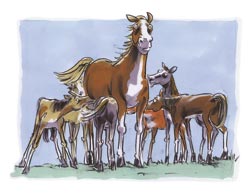
You may want to decide to take your mare away, perhaps
even back to the boarding stable where they were before
their foaled. You can pasture the mare full time with
several other mares since the familiarity of the situation
may be helpful. Some mares can be loaded easily. They may
fuss in the trailer for a few minutes, but they will often
be fine once they are turned out with their old pasture
mates.
Meanwhile you should place the foal in with at least three
other foals. The foal may run around for awhile and pay not
attention to the other horses or their feed. However, most
distress is usually short lived and by the next day the foal
wonít be looking for the mother and will have adapted to the
new surroundings.
However, you should always make sure you do your homework on
weaning. Although the separation is relatively painless it
is important to learn the best way to wean a horse. There
are several techniques that allow the foals to have less
stress.
In Middleburg, Virginia the researchers at Virginia Techís
M.A.R.E. Center started a group method of weaning with
groups of 12 mare and foal pairs. They removed a few of the
mares from the group and then waited three or four days
before removing some more. Eventually only one mare was left
as a babysitter. The foals were anxious for a day but since
they were with their pasture mates and in familiar
surroundings they werenít as stressed. Those who are
abruptly separated may face more stress.
The gradual method of weaning is advocated by some which is
the process where the foal goes to an adjacent corral for a
time and each day the length of separation is increased.
This way the mare and foal can still see each other, but
they will spend more time apart and become more independent.
While this process can sometimes take up to two weeks it
also alleviates the most stress for the horses.
The M.A.R.E. Center found that the method that doesnít work
is when the foal is put into a stall while the mare is taken
away. There was much more stress since the foal was placed
in an entirely new setting after being on pasture with the
mare for twenty-four hours a day. However, if you have no
other option but to do it this way you should make sure the
mare and foal are in the stall together for several days
before you start weaning.
Virginia Tech and Rutgers did another research study which
determined that an equally stressed foal wonít help the
situation. Foal pairs who are both stressed when placed in a
single box stall together have more stress than when they
are weaned separately.
Your facilities will play a large role in how you wean your
horses. Without sufficient acreage the abrupt method wonít
work well. Both mare and foal will remain stressed as long
as they can hear each other. If you have only a few foals
the gradual method is the best option.
The foal should be receiving proper nutrition during the
whole process. There have been studies that have shown that
there is less weaning stress if the foals are used to eating
grain concentrates. When the foal starts eating the mareís
grain you should start feeding them using a creep feeder to
keep the mare out. Then by four months the milk from the
mare will no longer meet the energy requirements of the
foal. During the first three months you should feed one
pound per day for each month of age. Then you should switch
to feeding about 1.5 percent of the foalís body weight until
the weaning period.
There are enormous advantages to creep feeding. Foals are
larger and heavier as a result of the faster growth rates
when compared to non-creep-fed foals. Creep fed foals are
better able to cope with the stress of weaning and are less
affected by the weight loss when they are taken away from
the mare. This change in life will also give them less
trouble if they are already accustomed to eating feed.
When foals learn what the feed tub is about and havenít been
creep fed they will likely grow and put on weight rapidly,
but this isnít exactly positive. Developmental orthopedic
disease or DOD can develop from the rapid growth. The risk
can be lowered by creep feeding your foal.
Thoroughly inspect the area where the foal is going to be
during weaning and make sure your facilities are in order.
There should be not loose boards or nails in the stalls.
There should be safe fencing and high gates in the pastures.
Whether foals are weaned in a stall or in the pasture you
should remove halters. Halters can more easily get caught on
objects since they foal is fretting over the new situation.
This can result in serious injury or death. You shouldnít
deworm at this time. You should do it a week before weaning
and then wait until three weeks after.

|